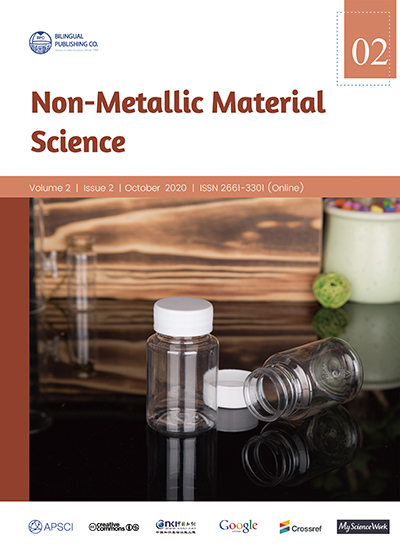-
252
-
242
-
225
-
202
-
127
Synthesis, Electrical Conductivity, and Dielectric Behaviour of Polyaniline Doped with H2SO4; HCl and (HCl + NaNO2) Mixture
DOI:
https://doi.org/10.30564/omms.v2i2.1899Abstract
Acid doped Polyaniline (PANI) due to their increased electrical conductivity, are considered to be the most promising conducting filler materials. Hence, the present study, reports the synthesis of the PANI followed by acid doping, electrical conductivity and dielectric properties measurements of H2SO4; HCl and (Conc. HCl + NaNO2mixture) doped PANI. In order to know the effect of acetone washing on the electrical properties of acid doped PANI samples, the electrical properties of the non-acetone washed acid doped PANI samples are compared with that of their acetone washed counterparts. The PANI salt was prepared by conventional route using aniline hydrochloride and ammonium persulphate as an oxidant. PANI salt was subjected to 0.5M NaOH to form PANI base, which was further doped separately with H2SO4; HCl and (Conc. HCl + NaNO2mixture) respectively followed by acetone washing. A comparative electrical conductivity study between the acetone washed and unwashed PANI salt and H2SO4, HCl and Conc. HCl + NaNO2 mixture doped PANI were characterized by dielectric and impedance study.
Keywords:
PANI; H2SO4; HCl; NaNO2; Dielectric permitivity; Electrical conductivityReferences
[1] Chutia P, Kumar A. Physica, 2014, B436: 200.
[2] Salaneck W R, Friend R H, Bredas J L. Physics Reports, 1999, 319: 231.
[3] Ameen S , Ali V , Zulfequar M, Haq M. M, Husain M. Current Appl. Phys, 2007, 7: 215.
[4] Basavaraja C, Kim J K, Thinh P X, Huh D S. Polymer Composites, 2012, 33: 1541.
[5] Cabezas A L, Feng Y, Zheng L R, Zhang Z B. Carbon, 2013, 59: 270.
[6] Hu W, Chen S, Yang Z, Liu L, Wang H. J. Phys.Chem. 2011, B115: 8453.
[7] John H,Thomas R M, Jacob J, Mathew K T, Joseph R. Poly. Comp., 2007, 28: 588.
[8] McCall R P, Scherr E M, MacDiarmid A G amd Epstein A J. Physical Review, 1994, 50: 5094.
[9] Upadhyay P K, Ahmad A. Chin. J. Poly. Sci, 2010, 28: 191.
[10] Xue Y, Quesnel D J. RSC Adv., 2016, 6: 7504.
[11] Yoo JE, Cross JL, Bucholz TL, Lee KS, Espe MP, Loo YL. J. of Mater.Chem., 2007, 17: 1268.
[12] Howard R. Synthetic Metals, 1989, 30: 257-263.
[13] Jia QM, Shan SY, Jiang LH, Wang Y.M. Adv. Mater. Res., 2011, 160-162: 1405.
[14] Saravanan S, Joseph C M, Anantharaman MR, Venkatachalam S and Prabhakaran PV. J. Phys. Chem. Solids, 2006, 67: 1496
[15] Chang Q, Li J, Gu D, Yin P, Jiang H and Shen L. J. Macromolecular Science, Part B: Physics, 2015, 54: 381-92
[16] Yoo J.E, Cross JL, Bucholz TL, Lee KS, Espe MP, Loo YL. J. Materials Chemistry, 2007, 17: 1268
[17] Stejskal J, Gilbert R.G., Polyaniline. Preparation of a conducting polymer, Pure Appl Chem, 2002, 74(5): 857-867.
[18] Epstein AJ, MacDiarmid AG. Macromol. Chem. Macromol. Symp., 1991, 51: 11.
[19] Heeger AJ. Faraday Discuss. ChemSoc, 1989, 88: 203-211
[20] Jain H. Experimental Techniques of Glass Science, The American Ceramic Society, Ohio, 1993.
[21] Limelette P, Schmaltz B, Brault D, Gouineau H, Autret-Lambert C, Roger SandGrimal V, Tran VF. J. Applied Physics, 2014, 115: 033712.
[22] McCall RP, Scherr EM, MacDiarmid AG and Epstein AJ. Physical Review B, 1994, 50: 5094.
[23] Epstein AJ, MacDiarmid AG. Macromol. Chem. Macromol. Symp., 1991, 51: 11.
[24] Mrlik M, Moucka R, Iicinova M, Stejskel J. Synthetic metals, 2014, 192: 37-42.
[25] Limelette P, Schmaltz B, Brault D, Gouineau H, Autret-Lambert C, Roger SandGrimal V, Tran VF. J. Applied Physics, 2014, 115: 033712.




 J. Mohanty
J. Mohanty





